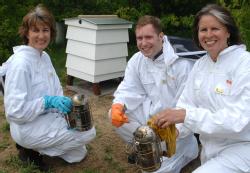Honey Bees arrive at University of Warwick’s Tocil Bee Habitat
 The University of Warwick’s Millennium Wood Meadow has some new residents – in the form of two colonies of honey bees.
The University of Warwick’s Millennium Wood Meadow has some new residents – in the form of two colonies of honey bees.
On Wednesday (May 19) local environmental artists Wendy Campbell-Briggs and Ann Loscombe oversaw the installation of the colonies as part of an important art project, known as The Tocil Bee Habitat.
The project began 18 months ago to raise awareness of the problems being experienced by British honey bees across the country.
Bees are responsible for the pollination of about one third of our food but if the sharp decline in honey bee population continues then the production of food will be placed under serious strain.
Entomologist and senior research scientist at Warwick HRI, Dr Dave Chandler, has been working with the two artists to help create the Tocil Bee Habitat.
Wendy said: “After our first meeting with Dr Chandler, it became apparent that together we could help people better understand the hard facts of science through the softer approach of art.
“If we could create the opportunity for a community to come together, to embrace biodiversity, we could begin to reverse the loss of our pollinators, the British honey bee.”
Wendy and Ann have created a wildflower meadow for the bees to take residency in and helped Mike S mith and Roger Wilkes of Warwickshire Beekeepers Association install the hives on Wednesday.
mith and Roger Wilkes of Warwickshire Beekeepers Association install the hives on Wednesday.
And the second major part of the project will see a 20 foot sculpture of a fox glove erected in the meadow in July.
“We came up with the idea of a flower, and as the foxglove is known as ‘the bee catcher’ it seemed ideal,” said Ann.
“The foxglove is another endangered species and provides great nourishment for bees and will be a reminder of the symbiotic relationship we have with our environment."
Dave Chandler added: “Honeybees are in serious decline across the northern hemisphere and projects like this are an important way of addressing the problem and in raising people’s awareness of the issue.”
When the project first got underway Wendy and Ann called on Warwick Volunteers to help them cultivate the land.
Peter Rose, Warwick Volunteers Manager, commented: “The creation of the meadow has been supported by enthusiastic students from Warwick Volunteers, who prepared and seeded the ground. They will also be developing educational materials about the meadow for use by local schools to further keep the plight of bees at the fore of everyone’s minds.”
The project will culminate with the installation of a permanent sculpture and showcase events during Warwickshire Artsweek 2010 on July 3, 4 and 6.
Notes to Editors
For the latest progress on The Tocil Bee Habitat project log on to http://blogs.warwick.ac.uk/beehabitatmeadow/.
For more information about the decline in honey bee population contact Dr Dave Chandler, Senior Research Scientist, on 02476 575041. For more details contact Luke Hamer, Assistant Press Officer, University of Warwick on 02476 575601 or email l.hamer@warwick.ac.uk.
